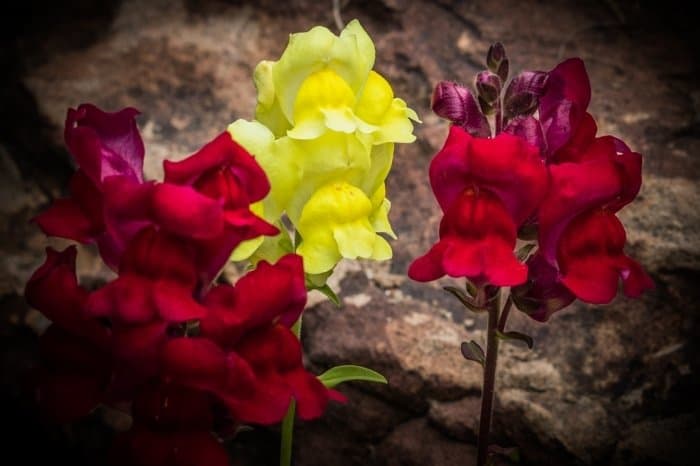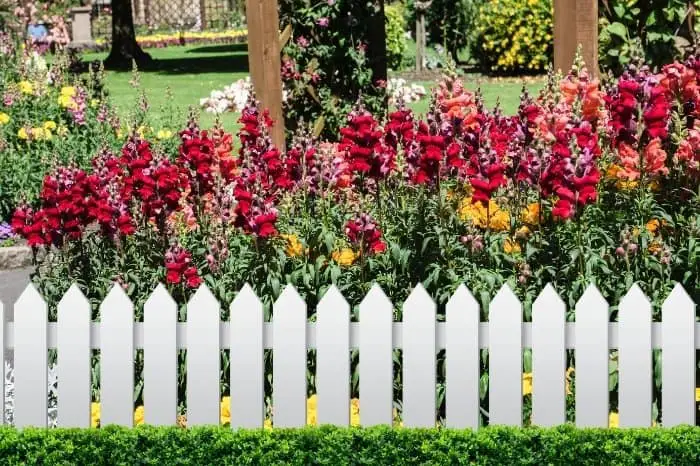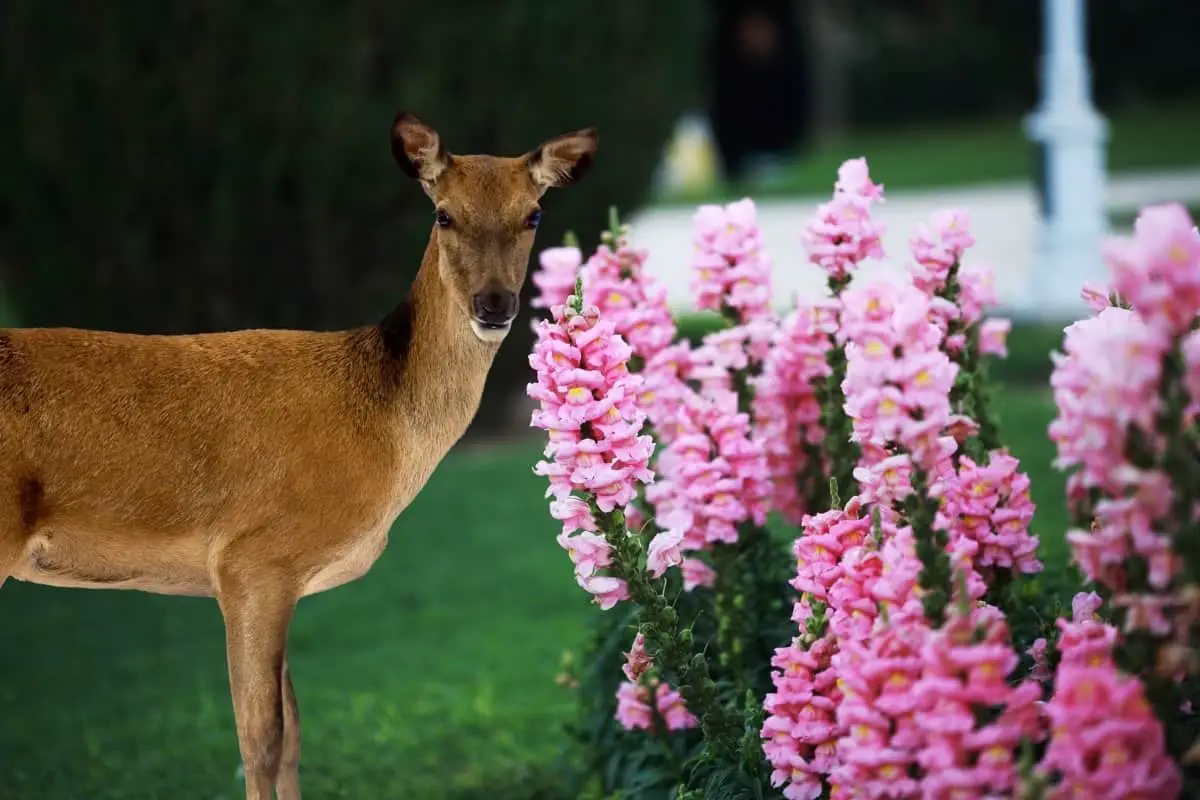Last Updated on January 31, 2022 by
Do deer eat snapdragons or they also revere them for having magical powers that were used in witchcraft in the past days?
A flower field or garden is beautiful with an array of floral colors and textures that are beautiful to behold. This beauty does not have to be destroyed by deer. However, you can establish a deer-resistant garden that will ensure you enjoy your crops and flowers without destruction.
Even though any flower can be damaged by deer, whether it’s classified as deer resistant or not, your main concern should be growing flowers that are not a favorite to these destructive animals.
Choose plants and flowers that deer do not enjoy eating and protect your farm by using barriers that will stop the roaming deer.
What Are Snapdragons?
Snapdragons are native to Spain and known by many names throughout Europe. Each name harkens to its nose-like features, for example, the dog-headed lion’s mouth, calf’s snout, dragon’s snout, toad’s mouth, etc.
Snapdragon’s scientific genus (Antirrhinum) comes from a Greek word meaning nose-like.
This flower is a favorite among modern-day witchcraft practitioners who associate it with protection. These flowers were worn on the sleeves as a charm to improve your social standing in the court. Even so, they are a favorite in gardens because of their beauty and the fact that they are deer resistant.

Snapdragon displays many colors of the rainbow grows up to at least 3 feet high. They are popular annuals and in some cases perennials.
These flowers have bright and attractive flowers, yet deer avoid them. There are about 40 different species of snapdragons; they make excellent cut flowers for your home.
These flowers are native to Africa and the Mediterranean area. They belong to the Scrophulariaceae, a family also called garden snapdragon and common snapdragon.
Snapdragons are growing mainly in the northeastern area of North America. They thrive in either full sun or partial shade and need consistently moist soil.
Are Snapdragons Deer Resistant?
Yes and no. No plant is 100% deer-proof. However, deer will only eat some plants, as a last resort and snapdragons are one such plant.
In general, deer tend to avoid strongly scented plants, thorny plants, and those with leathery leaves like yucca. Strangely enough, they will sample everything to learn what is more palatable.
There are also regional differences whereby deer eat and do not eat certain plants depending on the geographic location. There are differences in diet between herds of deer living in one neighborhood to the other.
Concentrated Deer Repellent – Bobbex | Deer, Elk, and Moose Deterrent Concentrate
Plants That Deer Like To Eat
Deer will eat almost anything they come across especially during spring. However, in a season when there is plenty of food, they love to eat narrow-leaf evergreens, especially fir and arborvitae.
Deer have a special love for daylilies, hostas, and English ivy. They feed heavily from October through February. Deer seem to prefer plants that have been fertilized.
Plants That Deer Do Not Like To Eat
Bear in mind, no plant is completely deer-proof. When food is in short supply, deer will eat almost any kind of plant and shrub. Nevertheless, deer do not like some plants that are deer-repellant. They include:
Fragrant Plants: Strongly scented plants cause deer to turn up their noses. These plants include herbs like lavenders, sages, peonies, ornamental salvias, bearded irises among many others.
Poisonous Plants: Daffodils, poppies, foxgloves, and monkshood are common flowers that carry toxins that deer avoid.
Fuzzy or Thorny Plants: Thorny or fuzzy plants are not some of the deer’s favorite. They include roses, lamb’s ear, spirea, among many others. Deer will only eat these plants only when they are desperate.
Bleeding Hearts: The popular Dicentra spectabilis is common among gardeners but not deer.
Deer Proofing Tip
Scare them away. Deer are frightened away by sudden movement and loud noises. You can hang wind chimes at the tree branches or shrubs in the garden or place wind spinners throughout your garden. If this doesn’t scare them enough, try startling them with a sudden spray of water or install a motion-activated sprinkler.
-
Use Other Plants To Dissuade Them. Interplant strongly scented perennial plants throughout your garden that deer hate. For example, French tarragon, mint, thyme, lavender, sage, rosemary, and chives.
-
Use Repellants Or Fertilizers. Deer love the tender shoots and new leaves groundcovers when they first appear in the spring. To eliminate this temptation, Use a strong repellant deer repellant to treat the area or use something that doubles up as a chemical-free fertilizer, like fish emulsion or blood meal. Be careful not to over-fertilize, as it will result in soft, succulent vegetative growth that deer will love to eat. Use only half dosage at a given time to bring in the odor but not overstimulate the plants.
-
Plant In Containers. You can use containers to grow your annuals. Place your containers on a balcony or front porch. You may also use hanging baskets that are placed too high for deer to reach.
-
Fence It In. If all of the above fails, then it’s time to get your garden a fence. Surround your garden with a tall deer fence or use other impenetrable barriers that will keep these destructive creatures away.

Conclusion
If there is one enemy gardeners have in common, it is the unwelcomed deer and the cousin rabbit. For many, these two are some of the most destructive animals you can ever come across.
When deer are hungry, they will treat your yard like a buffet, eating almost anything. This includes plants they have not bothered to eat in years.
Planting deer repellant plants that have strong odor and taste could also keep deer away but this might be temporal. Odor and taste repellants help reduce deer damage but not eliminate them.
Deer ignores the odor or bitter taste and keeps chewing these plants down. Choosing less appealing plants with fuzzy, prickly, or highly aromatic foliage is a step closer to keeping your garden safe.
Nevertheless, the best defense for deer is to erect a fence that is 9-inch high to keep them from jumping inside.
FAQs
What animal eats snapdragon flowers?
Humans do not eat snapdragons, although they are eaten by a variety of animals. Deer don't tend to eat them unless they have to. It turns out that deer are actually quite picky about their food choices and they will not eat flowers or certain flowers at all. The flowers are eaten by bees, butterflies and moths. Snapsprigs (Lemna minor) are often found in pond and lake margins and are easily mistaken for duckweed. They are also eaten by waterfowl.
Are perennial snapdragons deer resistant?
Perennial snapdragons are deer resistant. They should be planted in a spot where they will not get trampled by deer, but also not too far away from areas where deer would be likely to come looking for food. Deer may eat the leaves and flowers of plants such as snapdragons, but they generally leave most of the plant unharmed, so it is not usually an issue.
If deer do nibble on snapdragons, the plant will grow back. They do not have any trouble with deer or other small animals.
What animals eat snapdragon flowers?
According to an article, they are eaten by various birds. The article says that these flowers are also known as "nigella" or "annual black nightshade" in English speaking countries. Another article from the same website says that it is eaten by the bees.
What kind of flowers will deer not eat?
Deer eat all kinds of plants and are known to browse trees, shrubs, and flowers. However, there are some plants that deer do not eat. Deer will not eat: Rhododendrons Bermuda grass Azaleas In addition to the plants above, deer will not eat these plants:
If you have ever had a deer visit your garden, you know that Snapdragons are not the kind of flower that they are interested in. You might find a few on the ground after a visitation and then a couple more in the morning.
The best way to keep them from eating your plants is to make sure that they are not able to get into your garden.
What types of plants do deer eat?
Deer have a fondness for many types of plants. They are omnivorous, meaning they will eat plants and also animal flesh. In general, deer eat the leaves of plants. Deer also eat some types of fruits and flowers, although not in large quantities. Deer do not usually eat trees and shrubs, but they may browse on them if there is an abundance of tender new growth or if there are young buds or leaves.
Caroline is a gardener who loves to get down to the nitty–gritty of gardening. She proudly proclaims herself as a ‘dirt worshipper‘ and can often be found deep in the garden, covered in soil and singing to her plants. As a self–proclaimed ‘plant whisperer‘, Caroline believes that plants need love and attention just like any other living thing, and she loves to give them both. When she‘s not tending to her garden, you can often find her researching the latest gardening trends, or teaching others how to make their gardens thrive



